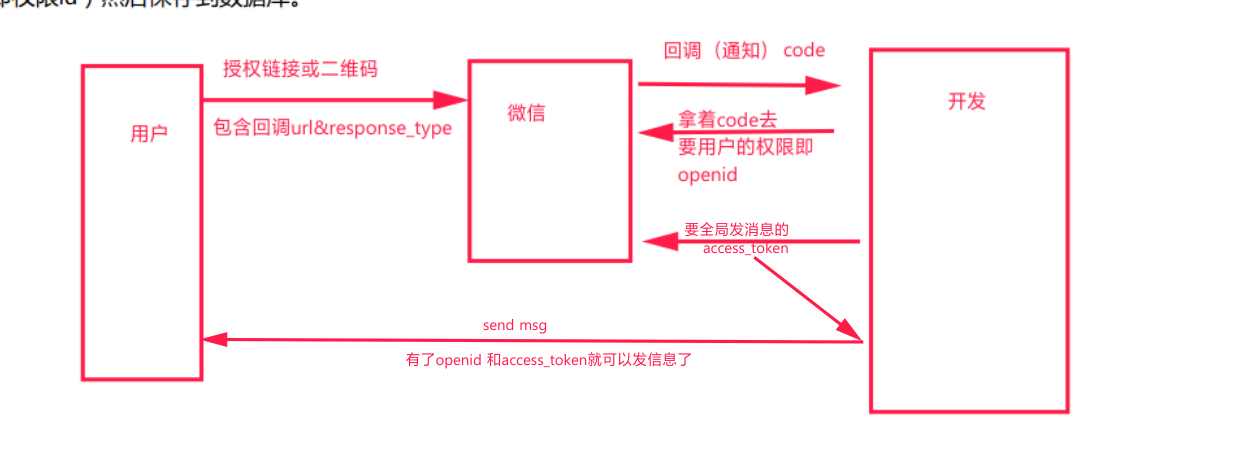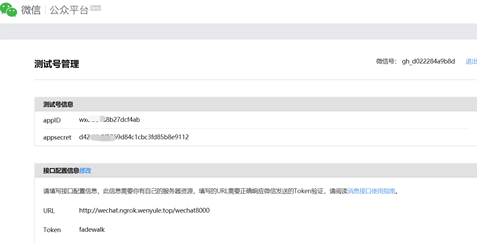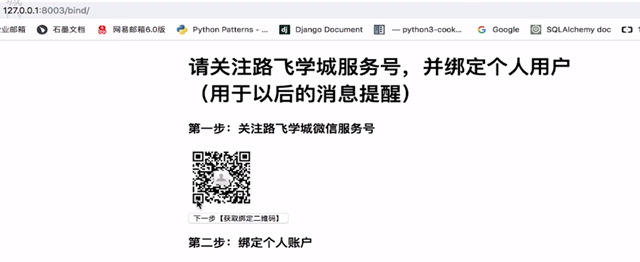开发中用的是测试号
微信公众号认证流程

用户登陆

<!DOCTYPE html> <html lang="en"> <head> <meta charset="UTF-8"> <title>Title</title> </head> <body> <form action="/login/" method="post"> {% csrf_token %} <input type="text" name="user" placeholder="用户名"> <input type="password" name="pwd" placeholder="密码"> <input type="submit" value="登录"> </form> </body> </html>

{% load staticfiles %}
<!DOCTYPE html>
<html lang="en">
<head>
<meta charset="UTF-8">
<title>Title</title>
</head>
<body>
<div style=" 600px;margin: 0 auto">
<h1>请关注路飞学城服务号,并绑定个人用户(用于以后的消息提醒)</h1>
<div>
<h3>第一步:关注路飞学城微信服务号</h3>
<img style="height: 100px; 100px" src="{% static "img/wx.png" %}">
</div>
<input type="button" value="下一步【获取绑定二维码】" onclick="getBindUserQcode()">
<div>
<h3>第二步:绑定个人账户</h3>
<div id="qrcode" style=" 250px;height: 250px;background-color: white;margin: 100px auto;"></div>
</div>
</div>
<script src="{% static "js/jquery.min.js" %}"></script>
<script src="{% static "js/jquery.qrcode.min.js" %}"></script>
<script src="{% static "js/qrcode.js" %}"></script>
<script>
function getBindUserQcode() {
$.ajax({
url: '/bind_qcode/',
type: 'GET',
success: function (result) {
console.log(result);
$('#qrcode').empty().qrcode({text: result.data});
}
});
}
</script>
</body>
</html>
关注公众号的
然后绑定权限
模板信息的新建
用户登录,
关注公众号,刷二维码或点击链接(向微信服务器说授予某公众号应用权限),微信服务器再通过二维码里面回调url(绑定时里面链接或二维码的重定向url),通知开发服务器,我们在通过微信服务区通知我们的url里面的code,请求获取用户的openid(即权限id)然后保存到数据库。

import json import functools import requests from django.conf import settings from django.shortcuts import render, redirect, HttpResponse from django.http import JsonResponse from app01 import models # 沙箱环境地质:https://mp.weixin.qq.com/debug/cgi-bin/sandbox?t=sandbox/login def auth(func): @functools.wraps(func) def inner(request, *args, **kwargs): user_info = request.session.get('user_info') if not user_info: return redirect('/login/') return func(request, *args, **kwargs) return inner def login(request): """ 用户登录 :param request: :return: """ # models.UserInfo.objects.create(username='wen',password=123) if request.method == "POST": user = request.POST.get('user') pwd = request.POST.get('pwd') obj = models.UserInfo.objects.filter(username=user, password=pwd).first() if obj: request.session['user_info'] = {'id': obj.id, 'name': obj.username, 'uid': obj.uid} return redirect('/bind/') else: return render(request, 'login.html') @auth def bind(request): """ 用户登录后,关注公众号,并绑定个人微信(用于以后消息推送) :param request: :return: """ return render(request, 'bind.html') @auth def bind_qcode(request): """ 生成二维码 用户点击或扫描用于向微信服务器发送绑定某个微信公众号的请求(用户到微信服务器的公众号处报到) 链接里面会含有重定向的url,和从微信请求携带的code(用于重定向的url再次向微信服务器请求用户openid) :param request: :return: """ ret = {'code': 1000} try: access_url = "https://open.weixin.qq.com/connect/oauth2/authorize?appid={appid}&redirect_uri={" "redirect_uri}&response_type=code&scope=snsapi_userinfo&state={state}#wechat_redirect " access_url = access_url.format( appid=settings.WECHAT_CONFIG["app_id"], redirect_uri=settings.WECHAT_CONFIG["redirect_uri"], state=request.session['user_info']['uid'] ) ret['data'] = access_url except Exception as e: ret['code'] = 1001 ret['msg'] = str(e) return JsonResponse(ret) def callback(request): """ 用户在手机微信上扫码后,微信自动调用该方法。 二维码中含有重定向的url, 用于获取扫码用户的唯一ID,以后用于给他推送消息。 :param request: :return: """ code = request.GET.get("code") #像微信服务器要的code # 用户UID state = request.GET.get("state") # 获取该用户openId(用户唯一,用于给用户发送消息) res = requests.get( url="https://api.weixin.qq.com/sns/oauth2/access_token", params={ "appid": settings.WECHAT_CONFIG["app_id"], "secret": settings.WECHAT_CONFIG["appsecret"], "code": code, "grant_type": 'authorization_code', } ).json() # 获取的到openid表示用户授权成功 openid = res.get("openid") print("get ",openid) if openid: models.UserInfo.objects.filter(uid=state).update(wx_id=openid) response = "<h1>授权成功 %s </h1>" % openid else: response = "<h1>用户扫码之后,手机上的提示</h1>" return HttpResponse(response) def sendmsg(request): def get_access_token(): """ 获取微信全局接口的凭证(默认有效期俩个小时) 如果不每天请求次数过多, 通过设置缓存即可 """ result = requests.get( url="https://api.weixin.qq.com/cgi-bin/token", params={ "grant_type": "client_credential", "appid": settings.WECHAT_CONFIG['app_id'], "secret": settings.WECHAT_CONFIG['appsecret'], } ).json() if result.get("access_token"): access_token = result.get('access_token') else: access_token = None return access_token access_token = get_access_token() print("---------",request.POST) # user_id = request.get() openid = models.UserInfo.objects.get(id=2).wx_id #获取用户id,而不是直接填一个数 print("send msg",openid) # def send_custom_msg(): # body = { # "touser": openid, # "msgtype": "text", # "text": { # "content": '要发送的内容...' # } # } # response = requests.post( # url="https://api.weixin.qq.com/cgi-bin/message/custom/send", # params={ # 'access_token': access_token # }, # data=bytes(json.dumps(body, ensure_ascii=False), encoding='utf-8') # ) # # 这里可根据回执code进行判定是否发送成功(也可以根据code根据错误信息) # result = response.json() # return result def send_template_msg(): """ 发送模版消息 """ res = requests.post( url="https://api.weixin.qq.com/cgi-bin/message/template/send", params={ 'access_token': access_token }, json={ "touser": openid, "template_id": settings.WECHAT_CONFIG['template_id'], "data": { "key": { "DATA": "lalal", "color": "#173177" }, "value": { "DATA": "关注本公众号", "color": "#173177" }, } } ) result = res.json() return result result = send_template_msg() print(result) if result.get('errcode') == 0: return HttpResponse('发送成功') return HttpResponse('发送失败')




